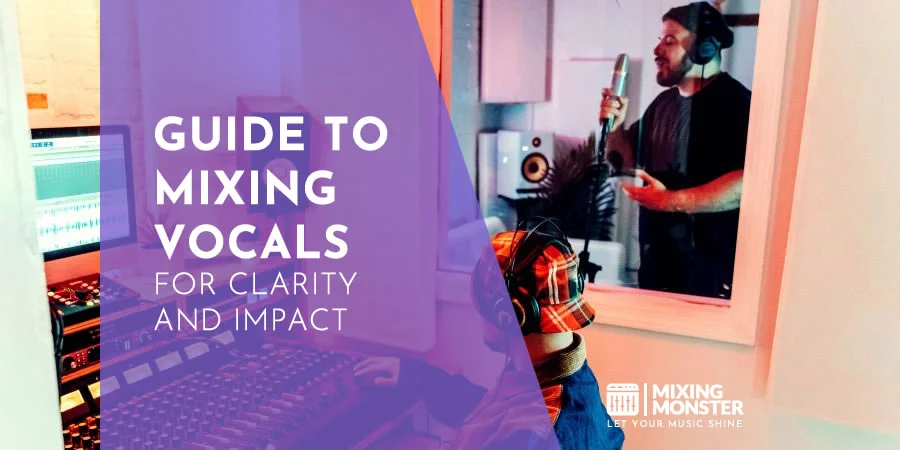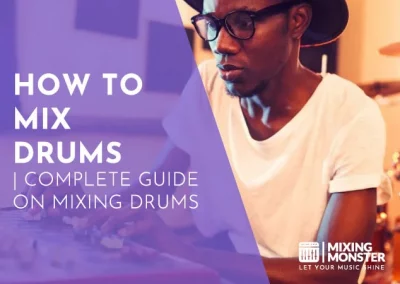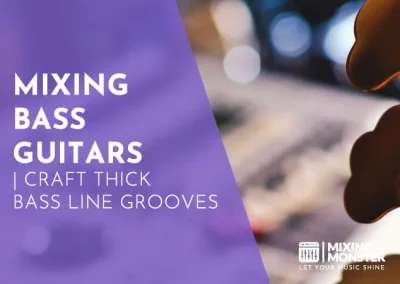Home > Blog > Mixing > Mixing Instruments
Disclosure: Some of the links below are affiliate links, meaning that at no additional cost to you, we will receive a commission if you click through and make a purchase. Read our full affiliate disclosure here.
Mixing vocals is a quintessential element of music production that can make or break a track. It’s the difference between a lifeless recording and a standout masterpiece that resonates with listeners. The process involves balancing the vocal tracks against the backdrop of instruments, ensuring clarity, warmth, and impact—a challenge that demands technical skills and creative intuition.
A well-mixed vocal commands attention, carrying a song’s melody and emotional weight while sitting perfectly in the mix. It starts with a pristine recording, followed by strategic editing, tuning, and the application of dynamic processing like compression and EQ. Reverb, delay, and other effects layer depth and space, enhancing the listener’s experience. Your vocals can achieve that polished, studio-quality sound with proper gain staging and an understanding of the frequency spectrum.
By exploring the intricate process of mixing vocals, you’re engaging with an art that bridges technology and human expression. This article will provide you with actionable insight into crafting vocal tracks that are both compelling and sonically pleasing. You’ll learn the how and why behind each step in the vocal mixing pathway, which will better equip you for your music production endeavors.
KEY TAKEAWAYS:
- Adequate vocal mixing enhances the emotional impact and clarity of a song.
- A combination of recording techniques and audio processing is essential for professional-sounding vocals.
- Learning the principles and practices of vocal mixing empowers you to produce superior music tracks.
Table Of Contents
1. Overview Of Mixing Vocals In Music Production
2. Fundamentals Of Vocal Recording
3. Setting Up The Vocal Chain
4. Editing And Comping Vocals
5. Vocal Pitch Correction Techniques
6. Vocal Compression And Dynamic Range Control
7. EQing Vocals For Clarity
8. Applying Vocal Reverb And Delay
9. Advanced Vocal Effects
10. Vocal Automation And Vocal Fine-Tuning
11. Mixing Backing Vocals
12. Finalizing The Vocal Mix
13. FAQ

1. Overview Of Mixing Vocals In Music Production
When you approach mixing vocals, think of it as finessing the voice to sit well within your track. Your main goal is to ensure clarity and balance and to complement the accompanying instruments.
Fundamental Elements
- Volume Levels:
Getting these proper forms the basis for a well-mixed vocal. - EQ (Equalization):
Helps you shape the tonal balance of the vocal. - Compression:
Used to manage dynamic range and to add consistency. - Effects:
Reverb, delay, and others can create space and texture.
Process Overview
- Balancing:
Start by setting a level for your vocals that fits with the rest of your mix. - Equalization:
Apply EQ to clean up muddiness and help the vocals stand out. Be careful to retain natural vocal qualities. - Compression:
A tool to smooth out the vocal performance, offering evenness in volume. - Spatial Effects:
Strategically use effects like reverb or delay to place the vocals in a three-dimensional space in your mix.
Every vocal is unique, and your approach should be tailored to the singer’s voice and the song’s genre. Patience with subtle adjustments will yield the best results.
2. Fundamentals Of Vocal Recording
The quality of your vocal tracks hinges significantly on the fundamentals you employ. Your first port of call is selecting an appropriate microphone. Ideally, you want a large-diaphragm condenser microphone, known for its sensitivity and frequency response, which is ideal for capturing the nuances of a vocal performance.
The physical space where you record is equally critical. Vocal recordings benefit from a quiet, well-treated room to avoid unwanted reverb or echo. If you’re in an untreated space, consider using portable sound absorbers to dampen the room’s acoustics.
Checklist For Vocal Recording Success
- Microphone Selection:
Choose a quality large-diaphragm condenser or dynamic microphone. - Room Acoustics:
Record in a quiet, well-treated space to prevent unwanted noise and reflections. - Mic Placement:
Keep the microphone at mouth level, around 6-12 inches from the source. - Pop Filter:
Use a pop filter to mitigate plosives that distort your recording. - Headphone Mix:
Give yourself a clear and balanced mix to ensure accurate monitoring.
It’s not just about the gear; a stellar vocal performance is necessary. Encourage relaxation and confidence in the vocalist. The emotional delivery can make or break a track. Lastly, gain staging during the recording process is essential. Set your levels to peak around -6dB to -3dB, leaving enough headroom for post-processing without risking distortion from clipping.
3. Setting Up The Vocal Chain
Setting up your vocal chain efficiently can transform your vocal tracks from raw recordings into polished, professional-sounding elements of your mix. It involves selecting an appropriate microphone, properly adjusting gain levels, and applying fundamental audio processing effects.
Choosing The Right Microphone For Recording Vocals
When recording vocals, your choice of microphone dramatically impacts the quality of the raw track. Large-diaphragm condenser microphones are often recommended for their sensitivity and wide frequency response, which can capture the nuances of vocal performances. Dynamic mics may be better suited for louder sources or live settings.
Initial Vocal Gain Staging
Proper gain staging is the foundation of a strong vocal recording. You want to adjust the gain on your preamp to avoid clipping while ensuring the signal is robust enough to stand out in the mix. Aim for a peak level of around -18 dBFS on your metering, which leaves enough headroom for further processing.
Implementing Basic Vocal Effects
Your vocal effects chain typically starts with EQ to remove unwanted frequencies and shape the tone of the vocals. A compressor follows, helping to even out the dynamic range and add presence to the vocals.
Additional effects might include reverb or delay, providing spatial context and depth to the vocal within the mix. It’s crucial to use effects tastefully to enhance, rather than overpower, the natural qualities of the vocal performance. Remember, the goal is clarity and balance.
4. Editing And Comping Vocals
In this section, you’ll understand how to polish your vocal tracks by removing unwanted background noise and selecting the best takes through comping. A clean, well-comped vocal can significantly elevate the final mix to a professional level.
Cleaning Up Vocal Background Noise
Before comping your takes, ensuring each one is as clean as possible is critical. Start by isolating your vocal tracks and listening carefully for background noise, such as hisses, hums, or unwanted clicks.
Employ noise reduction tools sparingly to avoid degrading the vocal quality. Precision is key; aim for subtle noise removal over aggressive filtering.
- Listen:
Identify noise during silent parts. - Reduce:
Apply noise reduction to minimal amounts. - Retain clarity:
Ensure you maintain a natural vocal tone.
Comping Vocals For The Best Takes
Comping is about constructing the ultimate vocal track. Your goal is to piece together a single performance from the best parts of each take. This is not about fixing imperfections but instead choosing moments that shine.
- Review:
Listen to all your takes. - Select:
Mark the best parts with clarity, emotion, and technical precision. - Create:
Form a comp track representing the best you offer.
Use tools like vocal comping to aid in this process. Always trust your ears; if it sounds good, it often is good.

5. Vocal Pitch Correction Techniques
In vocal mixing, pitch correction is essential to polish your vocal performances. Although a well-executed performance stands independently, slight pitch imperfections might still occur. Here is how you can address those:
Manual Correction
Manual pitch correction allows you to exercise granular control over the vocal line. As time-consuming as it may be, this process affords precision in tuning individual notes, ensuring the vocalist’s emotions and nuances remain intact.
- Step 1:
Isolate the off-pitch notes. - Step 2:
Adjust them until they align correctly with the desired pitch.
Automatic Correction
On the other hand, automatic pitch correction offers a faster solution. It can be less nuanced but is effective for minor, consistent inaccuracies:
- Select the key and scale of the track.
- Set the retune speed to control how quickly pitch corrections are applied.
Pros: It saves time and is good for subtle adjustments.
Cons: If overused, it can result in a synthetic sound.
Pitch Correction Plugins
Several software plugins offer sophisticated solutions for correcting pitches. Some popular pitch correction plugins—like the one offered by Auburn Sounds Graillon 2—even provide a free version suitable for live tunings and basic corrections.
Vocal Doubles
Use vocal doubles to thicken the vocal and naturally mask slight imperfections. This technique involves layering multiple takes of the same performance. While it’s not pitch correction per se, it complements the result, adding richness and depth to the lead vocal.
6. Vocal Compression And Dynamic Range Control
When mixing vocals, managing dynamic range through vocal compression is vital. By compressing, you ensure the vocal sits consistently in the mix. A compressor is a tool that reduces the dynamic range of your vocals – the difference between the loudest and quietest parts.
Vocal Gain Reduction
Gain reduction is a crucial concept in vocal compression. It is decreasing the volume of only the louder parts of your performance to match the quieter parts more closely. This doesn’t mean erasing the natural dynamics but keeping them controlled so that every word is heard clearly.
Vocal Limiting
Limiting is another form of dynamic control, similar to compression but with a much higher ratio. It’s beneficial for catching peaks that can cause clipping.
Vocal Compression Settings
Compressor settings are not one-size-fits-all and depend on the specific vocal track you’re working with. However, here’s a table outlining some common starting points that might help you:
| Setting | Typical Value | Description |
|---|---|---|
| Ratio | 3:1 to 4:1 | For moderate compression. |
| Attack Time | 1-3ms | Quick enough to catch peaks but slow enough to preserve vocal nuances. |
| Release Time | 40-60ms | Balances naturalness and control. |
| Threshold | Varies | Set according to the level of the vocals; aim for 3-6dB of gain reduction on the loudest peaks. |
| Gain Makeup | 3-6dB | Compensate for the volume lost during compression. |
Serial Vocal Compression
Serial compression involves using multiple compressors in sequence, each reducing slightly, for a more natural sound.
Remember, use your ears to guide your decisions. Compression should enhance the recording without losing the vocal’s emotion and character. In your DAW, tweak these settings to taste, and use your meters as visual feedback to supplement your auditory judgments.
7. EQing Vocals For Clarity
Achieving clarity in your vocal mix is paramount. Careful EQ adjustments remove unwanted frequencies and balance the vocal tonality, allowing the vocals to cut through the mix crisply.
Subtractive EQ In Mixing Vocals
Subtractive EQ is your first tool for enhancing vocal clarity in a mix. Begin by scanning for and reducing frequencies that are muddying the sound:
- High-Pass Filter:
Apply this filter to eliminate low-frequency rumble that is unnecessary for the vocal performance. - Low Mids:
Cutting a bit in the 200-300Hz range can help reduce muddiness and make room for clarity in the voice.
Remember, subtle cuts are often more effective than drastic ones. Over-EQing can lead to an unnatural sound.
Tonal Balance In Mixing Vocals
Maintaining tonal balance with EQ ensures that the vocals blend well with other track elements while standing out clearly:
- Midrange:
Presence in this range is crucial. Listen for any hollow or nasal tones between 1-2k Hz and adjust as necessary. - EQ adjustments:
Finer tuning in the 3-5k Hz region can add presence to a vocal or smooth out harshness.
Here’s a table of common EQ moves for mixing vocals:
| Frequency | Adjustment | Purpose |
|---|---|---|
| < 80 Hz | High-pass filter | Removes low-end rumble |
| 200-300 Hz | Cut | Reduces muddiness |
| 500 Hz | Cut | Diminishes ‘boxiness’ |
| 1-2k Hz | Boost or Cut | Corrects hollowness or nasal quality |
| 3-5k Hz | Boost or Cut | Adds presence or reduces harshness |
| > 10k Hz | High shelf boost | Adds airiness and detail |
Strike a careful balance with these adjustments, constantly referring back to the context of the full mix. Your EQ choices should support and enhance the vocal, allowing it to shine with transparency and detail.
8. Applying Vocal Reverb And Delay
Applying reverb and delay effectively can transform your vocal tracks from flat to full of life, allowing depth and texture to enhance your mix.
Creating Vocal Depth With Reverb
Reverb is fundamental when adding spatial effects to your vocals, providing a sense of environment. Think of it as reflecting your voice within a space, from tight rooms to vast halls.
The right balance can make your vocals sit perfectly in the mix. Below is a table of common reverb types and settings to ensure your vocals have depth without drowning in the effect:
| Reverb Type | Pre-Delay | Decay Time | Usage Tips |
|---|---|---|---|
| Room | 10-30 ms | 0.5-1.5 s | Ideal for a natural, intimate sound |
| Plate | 20-50 ms | 1.5-2.5 s | Adds a smooth finish for a polished sound |
| Hall | 30-60 ms | 2-10 s | Creates a dramatic, spacious effect |
| Spring | 5-15 ms | 1.2-2.2 s | Offers a vintage vibe with a bouncy character |
Using Vocal Delay For Texture
Delay, when used sparingly, can add sophistication and texture to your vocals. Unlike reverb, delay repeats the vocal at set intervals, thickening the vocal lines and adding rhythm. Be cautious with the feedback and blend settings to avoid muddiness.
Here’s a table with common delay settings that can enhance your vocal mix:
| Delay Type | Time Setting | Feedback Amount | Tips |
|---|---|---|---|
| Slapback | 75-150 ms | Low | Great for rock and country genres to add a sense of presence |
| Tap/Echo | 1/4 note or 1/8 note | Moderate | Use with tempo-sync for musical rhythm |
| Doubling | 20-30 ms | None to very low | Thickens vocals subtly for a fuller sound |
| Ping Pong | 1/4 note or 1/8 note left/right variation | Moderate | Creates a stereo effect that can liven up a flat mix |
Remember, the key to utilizing reverb and delay is a reasonable approach—less is often more. Your goal is to complement the vocal performance, not overwhelm it. Use these settings as starting points and adjust according to the needs of your track.
9. Advanced Vocal Effects
Applying advanced vocal effects in music production can take your mix to the next level. When you explore beyond basic compression and EQ, you uncover a world of creative effects that can enhance the character and quality of your vocal tracks.
Vocal Saturation
Apply vocal saturation sparingly to add warmth and fullness to your vocals. It introduces subtle harmonics that can make your vocals more present in the mix without overwhelming the other elements.
De-Essing Vocals
- Purpose:
Minimize harsh “sibilant” sounds (like “s” and “sh”). - Placement:
Typically after EQ and compression in the signal chain. - Tips:
Use it judiciously to prevent the vocals from sounding dull.
Vocal Harmonic Exciting
This can add sparkle to your vocals, making them stand out and grab the listener’s attention. It increases the perceived loudness and presence of the vocal without significant volume changes.
| Creative Effect | When to Use |
|---|---|
| Chorus | To add depth and motion to background vocals |
| Flanger/Phaser | For a psychedelic or sweeping effect on select phrases |
| Reverse Reverb | To create a haunting pre-echo leading into lyrics |
10. Vocal Automation And Vocal Fine-Tuning
Vocal automation plays a crucial role in mixing by allowing you to sculpt the vocal performance to perfection. It involves dynamically adjusting various parameters over time during the track to enhance the expressiveness and clarity of the vocal sound.
Vocal Volume Automation
Volume Automation is your tool for managing the singer’s dynamics throughout a song. It helps even out the performance by raising the level of softer phrases or words that may otherwise be lost in the mix.
- Increase volume for emotional power.
- Decrease volume to allow space for other instruments.
Gain Automation:
Similar to volume automation, gain automation affects the signal level before it hits the effects chain, letting you fix problems at the source of the signal path.
Vocal Panning Automation
Use panning to place the vocal in the stereo field, adding movement or making room for other elements in the mix.
| Parameter | Use | Effect |
|---|---|---|
| Panning | Left or Right | Adds spatial orientation to the vocals |
| Volume | Up or Down | Balances vocal dynamics |
| Gain | Before Effects | Corrects signal level inconsistencies |
Vocal Fine-Tuning Techniques
- Compression:
To maintain a consistent vocal level. - EQ:
To accentuate or reduce frequencies for a cleaner vocal sound.
By employing these techniques, you ensure that the vocals are both dynamically engaging and sonically present in your mix. Remember, automation should be used judiciously to enhance the vocal track without paying attention to the adjustments.
11. Mixing Backing Vocals
When you mix backing vocals, you aim to create harmony and support for the lead vocals without overpowering them. Pay particular attention to blending and managing harmonies to achieve this balance.
Blending Backing Vocals With Lead Vocals
Blending backing vocals with lead vocals requires careful level balancing and EQ management. Start by setting levels where backing vocals complement rather than compete with the lead.
Use an EQ to roll off lower frequencies that might muddy the lead vocals, and consider subtle boosts in the presence frequency range to help backing vocals cut through the mix without being too aggressive.
- Level Balancing:
- Set backing vocal levels lower than the lead vocals.
- Use automation to adjust dynamically throughout the track.
- EQ Techniques:
- Apply a high-pass filter to remove low-end rumble.
- Boost the presence slightly if backing vocals need to cut through.
Managing Vocal Harmonies
Harmonies add depth and texture but can clutter a mix if not handled with care. Prioritize clarity by ensuring each harmony part has its own space.
This often involves panning and applying different EQ curves to each harmony line to avoid frequency overlap that can lead to muddiness.
- Panning Harmonies:
Pan backing vocals slightly to the left and right of the center to create space. - EQ And Compression:
EQ each harmony line differently to ensure clarity. Use compression with a moderate ratio and adjust the threshold to achieve a consistent level of 3-6 dB of gain reduction on peaks.
The process of vocal comping can further enhance your backing vocals by selecting the best takes to ensure consistency and performance quality across all vocal parts.
12. Finalizing The Vocal Mix
In this final stage, you’ll polish your vocals to ensure they shine in the context of the entire mix. A professional vocal mix hinges on attention to detail and refined adjustments that elevate them from simply sounding good to great.
Key Takeaways For Mixing Vocals
- Use A Reference Track:
Compare your vocal mix to a professional one you admire. This can guide you towards a polished sound that competes in your genre. - Vocal Mixing Chain:
Your vocal mixing chain is crucial. It typically includes EQ, compression, reverb, and delay. Make nuanced adjustments based on the vocal’s role in the song. - Tailor Reverbs And Effects:
Apply reverb and delay sparingly. Shape them to complement the vocal track, creating space without muddying the mix. - Volume Automation:
Manually automate the vocal’s volume to maintain consistency and presence throughout the track. - EQ For Clarity:
Use EQ to correct and enhance clarity and presence in your vocals. Subtle boosts or cuts can make a significant difference. - Dynamic Processing:
Compress carefully to control dynamics while preserving the natural performance qualities. - De-Essing:
Apply a de-esser to tame harsh sibilance without affecting the overall vocal tone. - Check-In Mono:
Ensure your vocal mix sounds good in mono to confirm its strength in any listening environment. - Regular Breaks And Fresh Ears:
Take breaks to avoid losing perspective. Returning with fresh ears can reveal aspects that require fine-tuning. - Templates:
Consider creating Templates based on your successful mixes to streamline your workflow in future projects.
Always step back and listen to your mix as a whole. Ensure that your vocals fit seamlessly within the broader sonic landscape of your track!
Happy vocal mixing!
13. FAQ
1) What level should vocals be set at within a mix?
Your vocals should typically sit clearly above the mix without overpowering it. The exact level varies, but a good starting point is ensuring your vocals peak around -6 to -3dB for a balanced mix.
2) Which effects are essential for a basic vocal mixing chain?
Essential effects for a vocal mixing chain include equalization to balance frequencies, compression to even out dynamic range, reverb or delay for spatial depth, and occasionally a de-esser to reduce sibilance.
3) What are common beginner mistakes in vocal mixing?
Beginners often make the mistake of over-processing with too much EQ or compression, not leaving enough headroom, and neglecting to clean up unnecessary background noise or breath sounds before applying effects.
4) How can I achieve professional vocal sound using FL Studio?
To achieve a professional vocal sound in FL Studio, carefully adjust the built-in plugins to fit the vocal’s dynamic and tonal characteristics, and consider investing time in learning advanced features like the mixer and FL’s parametric EQ 2.
5) What techniques are used for mixing vocals in a live environment?
In live environments, apply swift EQ adjustments to adapt to room acoustics, utilize compression to manage levels on the fly, and monitor feedback frequencies to apply notches. Live vocal mixing often focuses on clarity and consistent levels.
6) How long does the process of mixing vocals typically take?
Mixing vocals takes time, depending on the project’s complexity and your experience level. A basic mix might take a few hours while fine-tuning a professional studio recording could require days. Patience and a critical ear are key.



















